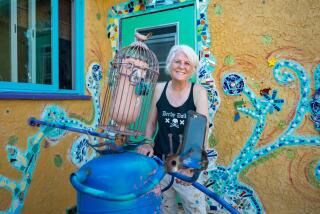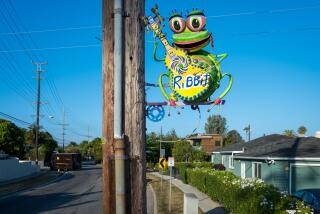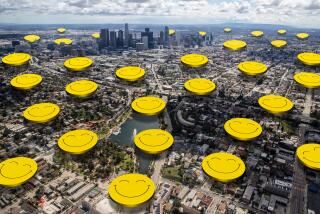Drive-By Sculpture Puts Controversy in Fast Lane
Practically nobody in West Hollywood seems indifferent to the city’s splashy exhibition of 16 massive sculptures on the Santa Monica Boulevard median.
Some residents love the outdoor show, whose installation was completed last weekend.
“The positive energy from these works adds to the continuing improvement of the boulevard,” J. Chase Langford enthused in a letter to Mayor Stephen Schulte. “I can’t tell you what a relief the artwork is after driving through miles of bombardment by commercial signs.”
Antipathy to ‘Change’
Others hate the exhibition, “Process of Change,” which features the works of 15 Los Angeles-area artists.
“I don’t believe these large, distracting sculpture pieces should be placed on a busy thoroughfare,” resident Edward Kovach said in a letter to the city. Kovach added that he was nearly rear-ended by a driver who “was gawking at the ‘art’ instead of the road.”
Critics include several West Hollywood gallery owners who said in interviews that they do not find the works aesthetically pleasing.
“I’m afraid I don’t like it, although I have to qualify that by saying that this is only my personal taste,” said Rosamund Felsen, owner of Rosamund Felsen Gallery. She called the show is “a visual eyesore” and said that “landscaping would be more desirable.”
Gallery owner Richard Kuhlenschmidt said the works chosen by the city “wouldn’t be something I would have put out there.” Gallery owners should have been consulted, he said.
Art dealers said that the prominent placement of large sculptural works in the heavily traveled boulevard median may be misconstrued as representative of West Hollywood gallery owners’ tastes.
Although gallery owners say they have received predominantly negative comments, participating artist Adam J. Leventhal said that “95% to 99% of the people I’ve heard from are really excited about it.” The few passers-by who shouted unprintable jibes as he was installing his work “did not have the guts to come up and discuss it,” he said.
Walking a Thin Line
Leventhal’s entry in the show is called “High Wire Act,” a massive head and hand with a figure on a tightrope suspended between them.
The exhibition, to be on view for about six months, is the largest of its kind sponsored by the 2 1/2-year-old city of West Hollywood, according to Ian Tanza, fine arts coordinator.
“This show has raised considerable comment in the community, some negative and some positive,” he said.
Controversy is understandable in a show that features experimental work by emerging artists, he said. “One definition of art is that it evokes response,” he said.
Tanza said West Hollywood city officials are very pleased that the show has generated such public interest.
The purpose of the city’s sponsorship of art in public places, Schulte said, “is to bring various forms of art from the interior of the museum to the places where people conduct their daily lives.”
The show, which has been nicknamed “Art in the Island,” will be seen by an estimated 40,000 motorists who drive along Santa Monica Boulevard through West Hollywood every day, he said.
This is the city’s third public art exhibition on the Santa Monica Boulevard median. The first was a nine-piece sculptural series, called “Reflective Man,” by Ross Nathan Power. The second was a sculpture by Nini Poli Cappelli that subsequently was donated to the city.
Consultant’s Idea
The current show originated in February from a proposal by independent art consultant Vicki Shipkowitz. She coordinated the show for the city without a fee.
The city allocated $15,000 from its Public Beautification Trust Fund for the installation and removal of the sculptures. The artists provided their works free to the city.
The trust fund was created by the city’s art-in-public-places ordinance, which requires a developer to pay the city a fee of 1% of a project’s value for the acquisition of public art for the project or elsewhere in the city.
Tanza said that because the city did not offer to provide insurance for the works, which stand exposed to traffic hazards, weather and vandalism, a number of artists did not wish to participate. Others were unable to take part because planning time was short, he said.
A panel of city staff members and Shipkowitz selected the works. Because of possible hazards the art may pose, preference was given to works with “break-away” designs “so as to pose as little threat to errant automobiles as possible,” Tanza said in his report to the board.
The city’s newly appointed nine-member Fine Arts Advisory Board has recommended that before any future exhibits, a formal process for public art selection be developed through public hearings.
Shipkowitz said the city of West Hollywood should be commended for being willing to take risks in providing a place where the public can see experimental art.
Those who might be intimidated by museums and art galleries are getting a chance to see the work of emerging artists in the 1 1/2-mile stretch of Santa Monica Boulevard, she said.
Of the critics, she said, “you are always going to have objections to anything new, especially from the dealers who are selling what we are giving to the public free.”
More to Read
The biggest entertainment stories
Get our big stories about Hollywood, film, television, music, arts, culture and more right in your inbox as soon as they publish.
You may occasionally receive promotional content from the Los Angeles Times.










